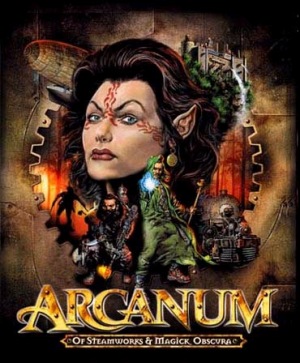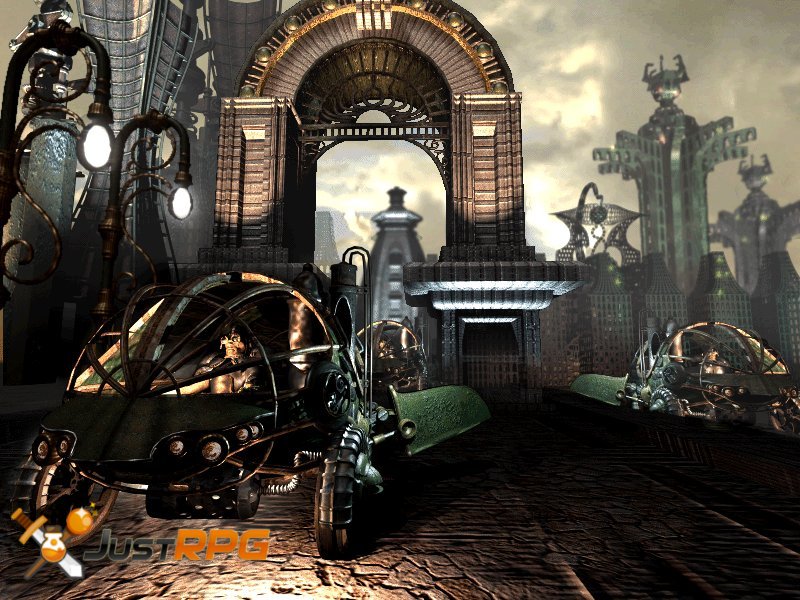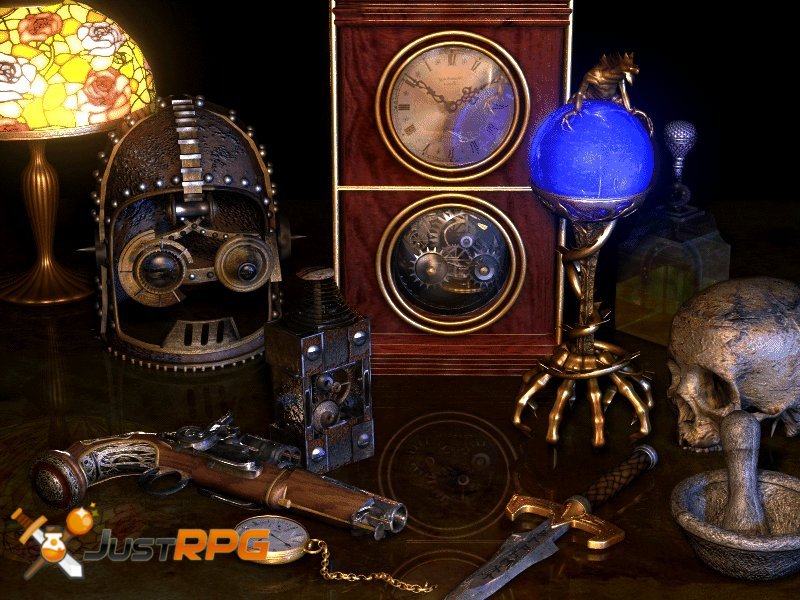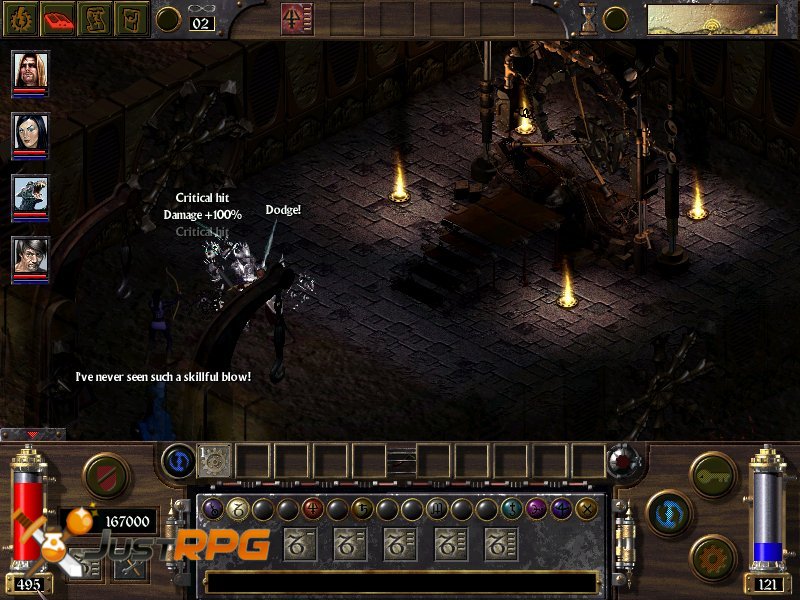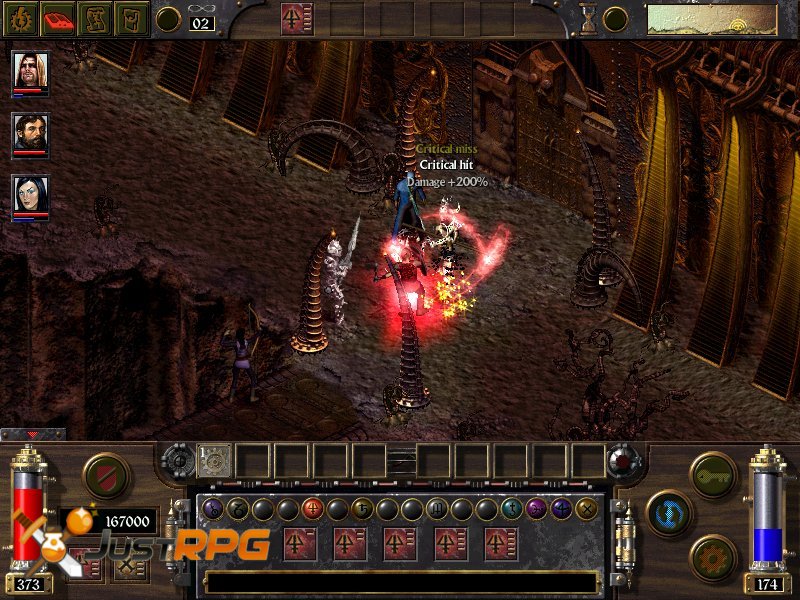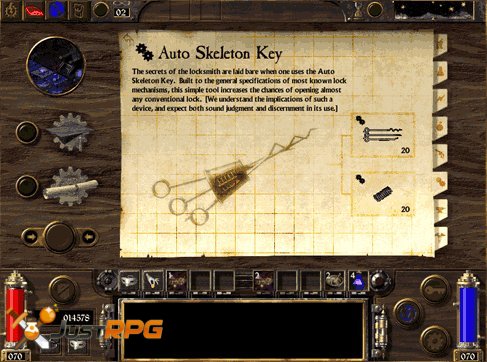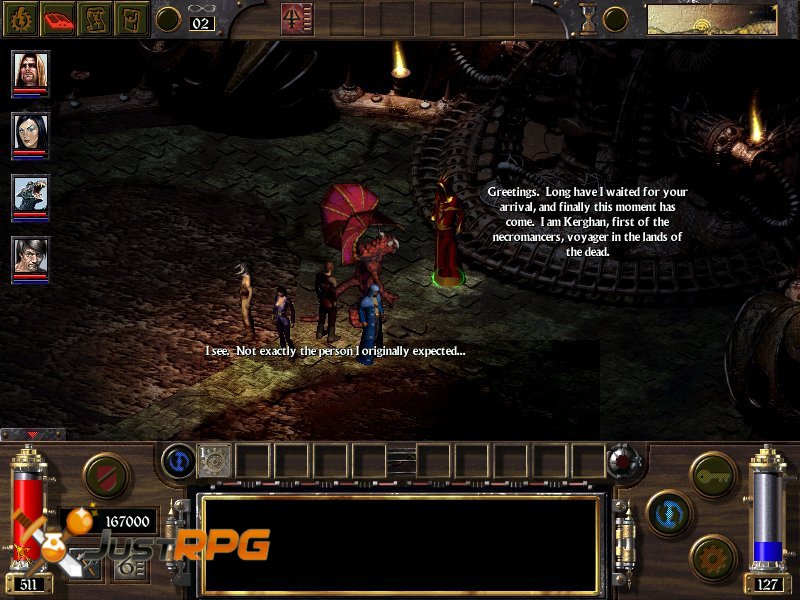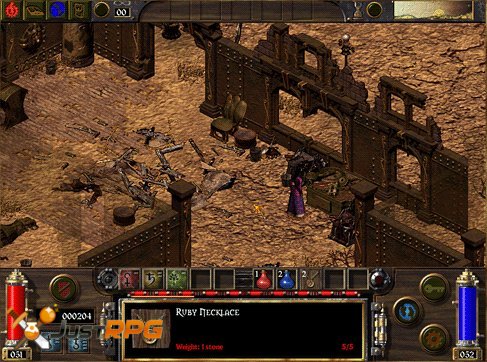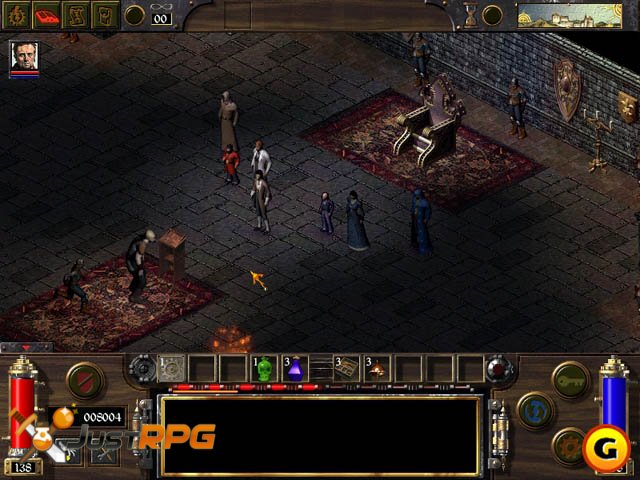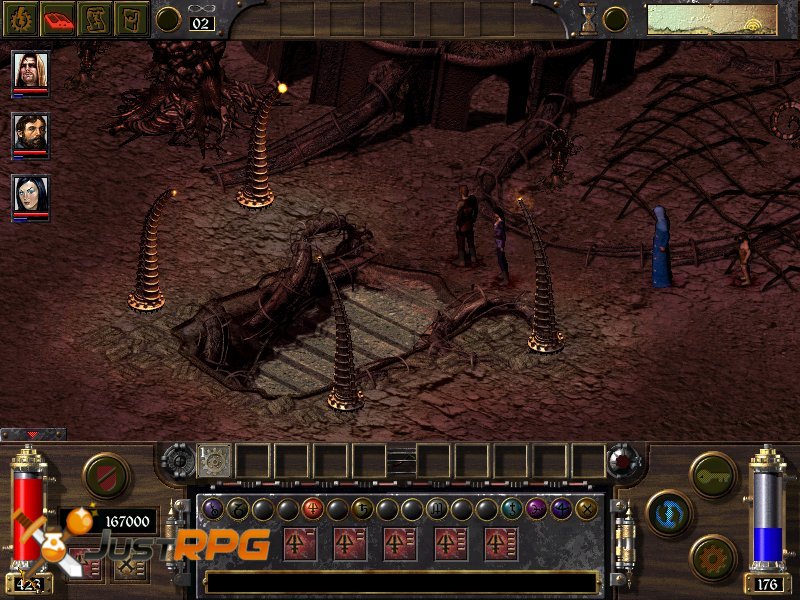Arcanum: Of Steamworks and Magick Obscura is a tasty treat for those truly dedicated to RPGs.
Full Review
Arcanum: Of Steamworks and Magick Obscura Review
When Fallout was released in 1997, it was hailed as a landmark RPG. Its post-apocalyptic setting was a welcome change from the relentless parade of D&D-inspired wizards and elves, and the concept of an RPG without magic was downright revolutionary. Add a delightfully flexible character development system and a jaunty out-of-left-field sensibility, and Fallout added up to be a great game. Its sequel was equally beloved by RPG fans.
Subsequent to the release of Fallout, several of the key members of the game’s creative team formed Troika games, and decided to see if they could shake the RPG world up once again.
The result of their labors is Arcanum, and it has a stunningly innovative basic premise. It takes place in a traditional fantasy world that is undergoing a mysterious industrial revolution. That’s right, sports fans, magic and tech pitted against each other in the same game! This is a tantalizing prospect for any RPG, and the good news is it’s not the only thing that’s special about Arcanum.
A Question of Character
Arcanum sports the most brilliantly open and flexible character creation and development system I’ve ever seen in a role-playing game. You pick your character’s name, sex, and race . . . and that’s just the beginning. Unlike many RPG class systems, which include many restrictions on weapons, skills, and classes, the world of Arcanum’s character building is limited only by your imagination. Beyond basic strengths and weaknesses (elves are better at magic, half-ogres are really strong, dwarves are good techies), the rest is up to you. Want to create a high-tech elf thief? Go for it. How about a gorgeous halfling diplomat?
The player gets to distribute a certain number of points among the character’s base attributes (Strength, Charisma, Dexterity, Beauty, Intelligence, Willpower, and Constitution). You then follow your own path, developing your stealth skills, your magic abilities, your traditional melee prowess, your technical expertise, and even your social skills.
There’s a tremendously fun optional feature in the character building system. It’s called Background, and it lets you choose a back story for your character that essentially lowers your base stats in one area significantly in order for a juicy bonus in another. There are dozens of these Backgrounds, and they have wonderful names like “Raised by Knife Throwers,” “Mad Scientist,” “Miracle Operation,” “Special Person,” (yes, it’s what you think) and my favorite, “Nietzsche Poster Child” (more critical failures but faster experience accumulation – a reference to the philosopher’s famous line “what does not kill me makes me stronger.”) I picked “Beat With An Ugly Stick” for my techie dwarf, and got a significant bonus to my intelligence in exchange for a bargain-basement beauty score.
As the game progresses and you are rewarded with points for experience, you can spend those points on beefing up your base attributes, developing a wide range of skills, or even getting “degrees” in tech or “magick.” The possibilities are so wide-open it almost causes vertigo.
The game starts out with one of the coolest opening movies I’ve ever seen in a game; it’s like something out of a primitive science fiction epic a la “From the Earth the Moon.” After surviving a harrowing zeppelin crash, you are accosted by a curious character who seems to think you are connected to some strange religious revival. You quickly get drawn in to the politics of the local town, but the realization that you’re the target of mysterious assassins grabs a certain amount of your attention as well.
As in most RPGs, you begin weak and poor, and begin building up your experience by doing minor quests around the first town. Can you help me rob this bank? Can you help me foil some bank robbers? Can you deal with the pesky bandits guarding the bridge leading out of town? Can you sabotage the new steam locomotive the mayor’s so proud of? There’s a lot going on, and the main plot has barely even been hinted at yet.
As you develop your character, you make decisions about whether you’re going to go the tech route, the magic route, neither, or something in-between. These decisions greatly affect not only your abilities to use tech and magic items, but also the reactions you get from other characters in the game. In other words, get too good at tech, and the salesman at the magic shop won’t even talk to you.
Over the course of the game’s huge story, there are many quests and sub-quests, and many of them are optional. The type of character you play also affects these quests greatly as well. Some quests are only available if you have very high charisma. Some quests are required to achieve mastery in a certain skill.
The amount of NPCs in your party is also dependent on your character. The bigger your charisma, the more people you can talk into joining you at any one time.
If this whole setup sounds intriguing and flexible, it is! And I can also report that, like any deep RPG should, Arcanum boasts a fascinating and detailed (and epic) storyline. I just wish I could say that the game is all good news. Alas, it is not.
The Bad, The Ugly, and The Boring
In attempting an RPG this ambitious, I’m afraid Troika has bitten off more than they can chew. For every cool feature of the game I can tell you about, there’s a dog of a feature to counteract it.
First up in the Bad News department is the game’s graphic design. The beautiful afore-mentioned opening cinematic notwithstanding, the general gameplay screen graphics in Arcanum are a surprising disappointment. The game is presented in 3rd person, overhead isometric view, and while the game takes place over a huge area, the environments are colorless and visually uninteresting. These days it seems like even bad games at least look good, so it’s a pretty big mistake for a game’s looks to be sub-par.
Next, movement and traveling are a big bore. Even basic movement around a town or large building is needlessly frustrating and cumbersome, and when you leave town to go journeying to your next major location, it gets really bad. Your party is constantly beset by hostile creatures that need killing. While this is valuable early in the game when you need to beef up your party’s stats, by the end of the game it becomes remarkably tedious. Especially since, on long journeys, you’ll often be interrupted for these meaningless little battles six, seven, or eight times!
The game also sports the dullest group of non-player characters I can remember enduring. The recent Bioware/Black Isle games have set the bar extremely high in this department. which probably makes this group of clods seem worse than they are. But compared to the rich parade of interactive characters in Planescape: Torment and the Baldur’s Gate series, the NPCs in Arcanum are about as exciting as an after-school Esperanto club.
The game’s worst failing, however, has to do with balance. Or, more specifically, lack thereof. Balance is a tricky tight wire act in any RPG. In a game with as much flexibility as Arcanum, it’s proved beyond the designers’ abilities. The experience point system, central to the game mechanics of any role-playing game, is ridiculously and (worse) illogically skewed in favor of the melee fighting style. The game rewards you points based on the number of times you whack a monster. So you rack up far more XP with a dull knife and low skill than with one good round of aggressive magic or devastating bullet from your rifle. I began the game excited to develop my tech skills, but began to get frustrated as I seemed to only be rewarded for putting points into the melee. So I ended up playing a tank – and I could have replayed Diablo II if I felt like playing a tank!
Even worse, by the game’s last third, I became such an overpowered character that the endless battles became stultifying exercises in tedium. I think it’s safe to say that if I can kill a full-grown grizzly bear with one or two swings of my sword, that things are a bit on the lopsided side.
I can imagine the talented designers at Troika advising me, “Well, try the game again, this time as an elemental mage! Or an explosives expert! Or a diplomat!” And while those would undoubtedly all provide with different game experiences, I was so exhausted by the time I finished Arcanum that the idea of ever playing the game again filled me with dread.
Best of Luck Next Time
Arcanum strikes me as a game that could have a great sequel. If the designers can figure out a way to achieve real and compelling balance in the game – and tart up the graphics a good deal – they might have a truly great game on their hands. What they currently have is an admirable experiment that fails.
Backdrop
.hack Part 1 Infection (Dot Hack) begins with a bang. Something disastrous happens to your character‘s real world friend, while innocently playing a 20 million-subscriber base, wildly popular online RPG game (MMORPG), The World. To unravel the mystery of your friend’s misfortune, you become an online, ingame rogue hacker, exploring every corner of The World, even some virus-infected ones.
The hero is armed with the special skills of Data Drain and Gate Hack, and some colorful, talented fellow adventurers to fill the two other available party slots. Different adventurers must accompany you depending on the plot‘s development. You have some control over the others in your party, including upgrading them through trades or gifts. You can play only a single class, Twin Blade. Other characters are from different classes, with varied strengths and weaknesses, from a mage type (Wavemaster) to a bully (Heavy Axeman).
Gameplay
Gameplay takes place in three principal areas – towns, fields, and dungeons. Towns house The World’s servers. There, the player can save the game, buy magic scrolls and useful and unique items, store items, buy equipment, and talk and trade with lots of other players in character online. One town has an unusual ranch to check out, a patent homage to an enduring feature of just about every Final Fantasy.
The town’s Chaos Gate provides instant teleportation to a particular wide-open Field, containing monster encounter hotspots, a mystical spring, treasure, and lots of mysterious food. You enter three distinct keywords, some known at the game‘s onset, and others learned through play. Whatever keywords are entered, the difficulty level of the destination is helpfully revealed. This prevents a low-level party from being massacred. Once the keywords are entered, you travel through the Chaos Gate. (You can enter specific keywords learned to continue the plot, do side quests, or do unlimited exploring. Or, you can instruct the Gate to enter random keywords, and take your chances. There‘s also an option to enter any keywords you wish from a word list.) Every Field houses a single Dungeon. The dungeons, where you spend much of the game fighting for your life, are not overly large in size, and always range between three and five average levels.
Many have compared Dot Hack to Phantasy Star Online Episode I and II (PSO) on the Gamecube. Let us gently discredit this. We feel Dot Hack has far better graphics than PSO. The Fields and Dungeons contain many colorful, over stylized backdrops and settings, including weather effects. Dot Hack’s monsters resemble the beautifully-drawn monsters of the later Final Fantasy’s. Dot Hack’s world is gigantic with a seeming infinite number of locations to explore. PSO’s world is relatively small, and plot is threadbare, with meaningless, though fun, side quests, which instill no enthusiasm in the player. Dot Hack’s plot is deep and complex, with each subplot advancing the story just a little bit further. (Remember though, the end of this game in no way comes close to wrapping up the story, to be completed in the three games to be released later this year.) One visual treat, however, was lifted directly from PSO – the cascading rings that accompany the teleportation of characters to and from different areas.
Combat
Dot Hack’s combat engine can best be described as modified real-time. Much like the action-RPG, Kingdom Hearts, button mashing can be effective to beat monsters. Monster combat icons appear as large yellow twirling landmarks. As you approach, the landmark dissolves, monsters come at you big-time, and, undoubtedly, players will feel a healthy adrenaline rush. Some of Dot Hack’s many monsters do not stand around waiting to be pummeled, rather some you need to catch. Dot Hack lets you turn combat almost into a turn-based affair. The player needs only to hit Triangle in the middle of battle to pause the game instantly. From there the player can give orders to the others in the party, anything from healing someone, reviving another, casting a spell, designating a target monster. Without jeopardizing your party from the hailstorm of monster blows, combat becomes a calmer, more strategic, experience. This will help the many action-challenged. Camera angles play a big role in successful combat. You must be facing a monster to do any damage. As in many games, manipulating opposing environmental elements, like fire vs. water, is a key to successful monster combat.
Dot Hack’s cyberspace setting provides a wealth of Wow-inducing outbursts. The Data Drain option in combat is a great example. When a monster’s approaches zero, the player can Data Drain to reduce a horrendous, gigantic steel robot, for example, into a sniveling, puny monster, easily defeated with a single blow. Data Drain always results in a nifty, rare item or essential Virus Cores so you can Gate Hack areas of The World now closed, but needing investigation. One bad side effect – if you defeat, a Data Drained monster, but a single experience point is earned. One REALLY bad side effect – if you Data Drain too often without giving the skill a rest, you may overload and explode. Game Over. In the case of Boss monsters, Data Drain works the same, but what remains is no sniveling puny monster, but a full-blooded slightly less tough monster. All of this makes for interesting and captivating combat, a large part of the game.
Fresh Features
Dot Hack is replete with new and interesting features that kept us riveted.
To start, the entire background and story of a real world gamer becoming a rascal hacker, penetrating deep into a virus-infected online game, is quite novel. Combine this with Dot Hack’s emulating the look and feel of an online game universe. (Message traffic on the web shows many gamers mistakenly believe Dot Hack is a real online MMORPG, along with monthly fees! No real Internet connection is required.)
Just like in the real word, Dot Hack replicates your excitement level when “New” appears before a popular forum or on your email screen. Some of the game involves receiving emails as the plot develops, as well as new, crucial information surfacing on The World’s Board. (Look out for emails challenging you to a strange game of Tag.) The online game world looks very familiar with a bunch of characters wandering around the game’s towns, with the ubiquitous balloon icons talking typical “trash” to each other, even criticizing “newbies“.
Combat grippingly called for surprisingly strategic decision-making to succeed, not related to the usual attack or defend choices. Do you go for experience and upgrade your character or try for some special equipment or a Virus Core, vital to Gate Hacking? The innovative control of other party members became second nature to us after some practice. The game rewards a player taking chances, like entering a Field or Dungeon rated 5 levels above the player’s current level. On the other hand, the game scoffed at players entering areas much lower rated the their current level, by awarding negligible experience points for victory.
Dot Hack takes progress reports to a new level, by slowly unlocking books that contain much in the way of statistics and information. There’s even a monster compendium with tips for defeating them.
Some might complain about the minimal “Save Game” ability, but we thrived on it. You explore a very hostile cyberspace environment without the facility to save. Only in a server-hosting town is saving possible at the local Recorder. We may be a solitary voice in the Wilderness, but we like this throwback to the good old RPG days. Those of you old enough to remember the Wizardry series, may recall those fingernail-biting multi-combat treks back to the Castle just to save the game. In case you’re really stuck deep in a dungeon, a common item will teleport you to the outdoor field, from where you can simply gate back to town from the command menu.
Many pieces of equipment come with distinctive powerful attack, healing, and status skills, essential to combat dominance. The player must tradeoff whether to equip something that will raise defense or offense or something less vigorous that lets you use a powerful skill. Trading is the most successful way to upgrade equipment.
In a first, Dot Hack comes with a 45 minute anime video. This gives some great background on what’s going on in The World, as well as provide clues for completing the game. In a nice twist, voiceovers for game speech can be set for Japanese or English presentation. Listening to the authentic Japanese voices really keeps you glued to the game.
Though some may scoff at what follows as meaningless, we liked the game’s unlocking of some nifty new “toys” to like, some only available when the game is cleared. You can unlock many different background music play lists. Tired of creepy tunes, just switch to something more upbeat, or futuristic. Just like real world gamers, who constantly change their desktop wallpaper, new and different wallpapers are unlocked along the way. Some are concept art of characters, while others are full blown anime renditions of the characters. This makes for great fun, and seems to pump additional energy into the game. As you progress over a dozen special cut scenes or movies will become viewable after defeating the game.
Though Dot Hack’s extras and new wrinkles enhance the RPG game experience, much of the gameplay will ring true to those who enjoy RPG‘s. Expect plenty of exploration in a huge 3D world, frequent monster combat, tons of treasure to earn and discover, upgrading your character’s weapons and armor, and needing to level before tackling pivotal story dungeons. The status screens for the characters and all equipment are well laid out and easy to grasp.
Time for Completion
Game length in hours always concerns many purchasers. A short RPG normally takes a lot of flack, and many online are asking about Dot Hack‘s time for completion. (Some have questioned whether Bandai should have released a single 80 hour game for $50, rather than four 20-hour games for $200 for a single story. This matter is beyond the scope of this review, but our high opinion of this game as a standalone is obvious.) Our experience, playing the plot without doing side quests or extra exploration, is in the 12 to 15-hour range. Players side-questing and extensively exploring, aside from the main plot, can expect to spend 25 hours to complete the game. You can even continue to advance your character, after game completion, to get a jump start on Part 2 due in May. In the next game, your character can be imported from Part 1.
Furthermore, imagine trying to explore every nook and cranny of the fields and dungeons accessible by a large number of 3-word combinations. Doing that would put the game in the 50-hour range, if not more. However, at a certain point, new items dry up, and a single experience point is earned for any defeated monster, no matter how tough.
Shortcomings
While, as is evident above, there is much to recommend in Dot Hack, certain concerns to varying degrees deserve mention.
From the “Why oh why did they leave this out?“ File. Pregame game board traffic and information about the Japanese version released months ago had many salivating for replaying the game in “parody” mode. This mode apparently converted all Dot Hack’s game world characters into satirical comedians. Sorry to say, this highly-anticipated feature is missing from the version released here.
The game requires massive amounts of button pressing. Every item or treasure uncovered from combat victories or exploration (opening chests, searching expired adventure remains, collecting food for Grunty’s, as examples) must be confirmed with a button press. When there could be 50-100 such occurrences in a single dungeon or field, over the course of the game, finger cramps seem inevitable. Baldur’s Gate: Dark Alliance also required lots of bashing for buried treasure and chests, but the items literally flew into your inventory, a much better way to handle this.
The manual is woefully terse and lacking in some crucial information and guidance. While the ingame tutorials fill in many of the gaps, one extremely important gameplay feature is missing from both the manual and tutorials – instructions on control your characters directly during combat.
Final Word
We got a kick out of Dot Hack. The feeling of “just one more dungeon” dominated our lives for the 3 days to completion. The engaging environment held our attention without much effort. The strategic nature of combat, plus the convoluted plot kept us going for hours on end. The constant unlocking of both frivolous and important gameplay features created a “what’s next” anticipation. Now, if I could only read Japanese better, Dot Hack Part 2 is already out in Japan!
Final Grade: B
Final Verdict: 78%

